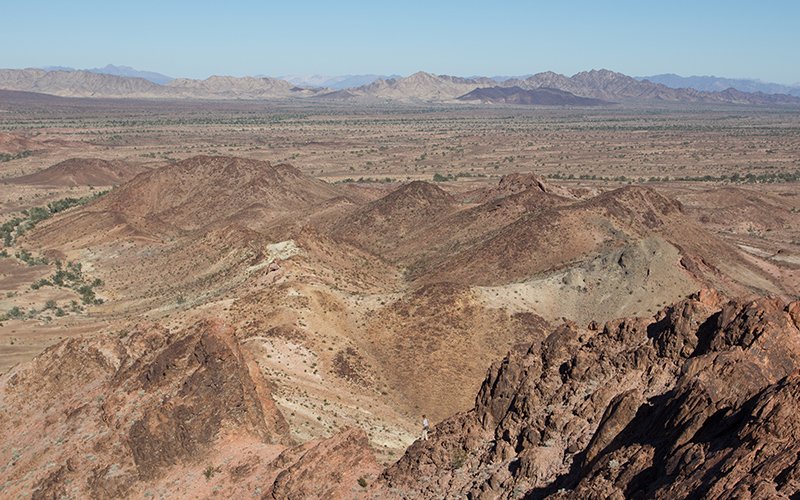Strategic Conservation: How Wildlands Supports Public Lands Beyond Preserve Boundaries
by Dave Herrero, Four Corners Regional Director
Chuckwalla Mountains Wilderness / photo by Jack Thompson
It is increasingly clear that successful conservation requires thinking and acting at the landscape scale. Species pay no attention to lines on a map. Rivers carve through jurisdictions. Migration routes stretch across borders. Natural systems operate across vast interconnected landscapes, demanding conservation approaches that match their inherent complexity.
The announcement of the Chuckwalla National Monument, as a critical piece of the unprecedented Moab to Mojave Conservation Corridor (MMCC), is a recognition of this reality. The MMCC, a network of protected lands stretching 600 miles and encompassing 18 million acres, creates meaningful connectivity between multiple major ecosystems — from the Colorado Plateau through desert systems to California mountains. Spanning these diverse landscapes, it protects a remarkable gradient of ecosystem types, from high plateau to desert valleys, preserving numerous ecological transition zones that harbor unique groupings of species. The inclusion of the Colorado River system adds crucial riparian corridors to this protected network. Additionally, the corridor's elevation of cultural values alongside ecological values represents a unique and holistic approach to conservation.
Yet even as we recognize these achievements, challenges to its overall integrity remain. The persistent opposition to federal land protections at places in the West demonstrates the vulnerability of public lands to political priorities. This vulnerability is particularly evident in the MMCC’s eastern anchor, where Bears Ears and Grand Staircase-Escalante National Monuments lie within the state of Utah’s borders. Because these Monuments were established through presidential authority under the Antiquities Act, and because the courts have not yet settled whether a president can reduce monuments designated by previous administrations, their boundaries and protections remain tenuous. The recent history of these Monuments reveals how dramatically these protections can shift with changing administrations — in just a few years time Bears Ears saw its protected area reduced by 85%, while Grand Staircase-Escalante’s boundaries were cut nearly in half, only to later have both restored to their original size. With the incoming administration already signaling its intent to open more federal lands to mineral exploration and potentially reduce protected areas, it could fragment this unprecedented conservation achievement at its foundation.
This uncertainty makes it more critical than ever for private conservation organizations to play a strategic role in landscape protection. At The Wildlands Conservancy, we've developed a model both innovative and ground-truthed: identifying and acquiring threshold preserves, keystone properties that can be leveraged to protect larger landscapes and advance broader conservation efforts. Our Speaking Springs and Whitewater Preserves exemplify this strategy — acquisitions of a few hundred acres that not only effectively protect tens of thousands of acres of adjacent public lands, but can be a stronghold to influence land management policy far beyond. And through direct engagement with visitors at these preserves, we create opportunities for education and advocacy that often don’t exist on public lands, helping citizens become effective voices for sound conservation policy.
This model of strategic private conservation, working to secure critical access points that amplify federal protection efforts, points to a larger truth: the success of landscape-scale conservation might ultimately depend on this complementary relationship between federal land management, engaged citizenry and private conservation organizations. While federal agencies provide the backbone of large-scale protection through designations like Bears Ears or Chuckwalla National Monuments, organizations like The Wildlands Conservancy secure critical threshold properties that help hold these systems together. Our ability to act decisively and maintain consistent conservation priorities offers a crucial counterbalance to the inherent volatility of federal land management under administrations with different priorities.
The establishment of Chuckwalla National Monument and the creation of the Moab to Mojave Conservation Corridor represent a watershed moment in American conservation. This unprecedented protected landscape, stretching from the Colorado Plateau to the California desert, demonstrates what is possible when we think and act at the appropriate scale. It is an achievement worth celebrating.
Yet important conservation work remains. As we applaud these broad federal protections, we continue to identify and protect the critical properties that connect and buffer these landscapes. Our ability to work in these interstitial spaces, securing key threshold properties that help hold these systems together, is necessary for their continued health. Together with our visitors, supporters, and partners who share our commitment to conservation, we work to protect these wild places – their ecological values, cultural heritage, and the opportunities they provide for connection with nature. Like the complex ecosystems we seek to protect, lasting conservation requires both the bold strokes of federal protection and the careful attention to the connections between them.
Speaking Springs Preserve surrounded by Bears Ears National Monument / photo by The Wildlands Conservancy
Whitewater Canyon, Sand to Snow National Monument / photo by Jack Thompson



